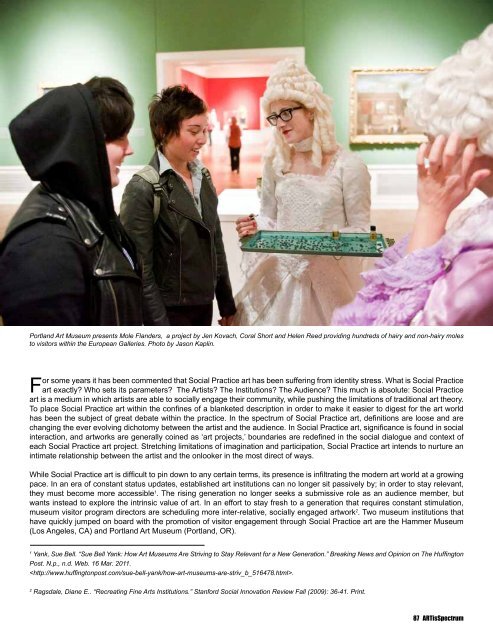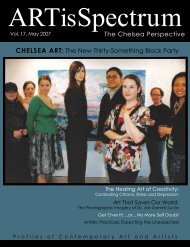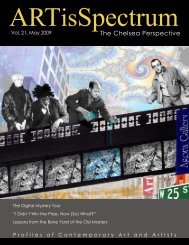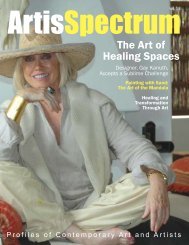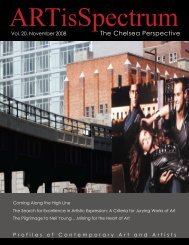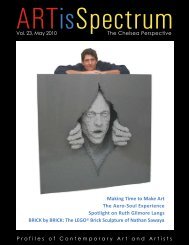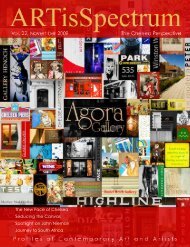Profiles of Contemporary Art and - ARTisSpectrum
Profiles of Contemporary Art and - ARTisSpectrum
Profiles of Contemporary Art and - ARTisSpectrum
You also want an ePaper? Increase the reach of your titles
YUMPU automatically turns print PDFs into web optimized ePapers that Google loves.
Portl<strong>and</strong> <strong>Art</strong> Museum presents Mole Fl<strong>and</strong>ers, a project by Jen Kovach, Coral Short <strong>and</strong> Helen Reed providing hundreds <strong>of</strong> hairy <strong>and</strong> non-hairy moles<br />
to visitors within the European Galleries. Photo by Jason Kaplin.<br />
For some years it has been commented that Social Practice art has been suffering from identity stress. What is Social Practice<br />
art exactly? Who sets its parameters? The <strong>Art</strong>ists? The Institutions? The Audience? This much is absolute: Social Practice<br />
art is a medium in which artists are able to socially engage their community, while pushing the limitations <strong>of</strong> traditional art theory.<br />
To place Social Practice art within the confines <strong>of</strong> a blanketed description in order to make it easier to digest for the art world<br />
has been the subject <strong>of</strong> great debate within the practice. In the spectrum <strong>of</strong> Social Practice art, definitions are loose <strong>and</strong> are<br />
changing the ever evolving dichotomy between the artist <strong>and</strong> the audience. In Social Practice art, significance is found in social<br />
interaction, <strong>and</strong> artworks are generally coined as ‘art projects,’ boundaries are redefined in the social dialogue <strong>and</strong> context <strong>of</strong><br />
each Social Practice art project. Stretching limitations <strong>of</strong> imagination <strong>and</strong> participation, Social Practice art intends to nurture an<br />
intimate relationship between the artist <strong>and</strong> the onlooker in the most direct <strong>of</strong> ways.<br />
While Social Practice art is difficult to pin down to any certain terms, its presence is infiltrating the modern art world at a growing<br />
pace. In an era <strong>of</strong> constant status updates, established art institutions can no longer sit passively by; in order to stay relevant,<br />
they must become more accessible 1 . The rising generation no longer seeks a submissive role as an audience member, but<br />
wants instead to explore the intrinsic value <strong>of</strong> art. In an effort to stay fresh to a generation that requires constant stimulation,<br />
museum visitor program directors are scheduling more inter-relative, socially engaged artwork 2 . Two museum institutions that<br />
have quickly jumped on board with the promotion <strong>of</strong> visitor engagement through Social Practice art are the Hammer Museum<br />
(Los Angeles, CA) <strong>and</strong> Portl<strong>and</strong> <strong>Art</strong> Museum (Portl<strong>and</strong>, OR).<br />
1<br />
Yank, Sue Bell. “Sue Bell Yank: How <strong>Art</strong> Museums Are Striving to Stay Relevant for a New Generation.” Breaking News <strong>and</strong> Opinion on The Huffington<br />
Post. N.p., n.d. Web. 16 Mar. 2011.<br />
.<br />
2<br />
Ragsdale, Diane E.. “Recreating Fine <strong>Art</strong>s Institutions.” Stanford Social Innovation Review Fall (2009): 36-41. Print.<br />
87 <strong>ARTisSpectrum</strong>


